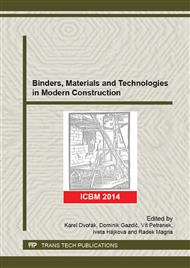p.3
p.7
p.11
p.17
p.21
p.25
p.30
p.36
Chemical Analysis of Historic Lime Mortars: Role of Sample Preparation
Abstract:
The characterization of historic lime mortars is crucial for many cultural heritage conservation issues. In this work, the characterization of a historical lime mortar is described. Samples for chemical analysis were obtained after different milling times and using the RILEM acid digestion method on several replicates. Qualitative and quantitative determination of phases in the mortar and in the residues after acid attack and the potential presence of CaCO3 polymorphs, were accomplished with X-ray powder diffraction. Results suggest that representativeness of the sample and the homogenisation, although not always achievable in conservation practice, are strongly affecting results.
Info:
Periodical:
Pages:
17-20
Citation:
Online since:
April 2015
Authors:
Keywords:
Price:
Сopyright:
© 2015 Trans Tech Publications Ltd. All Rights Reserved
Share:
Citation:


